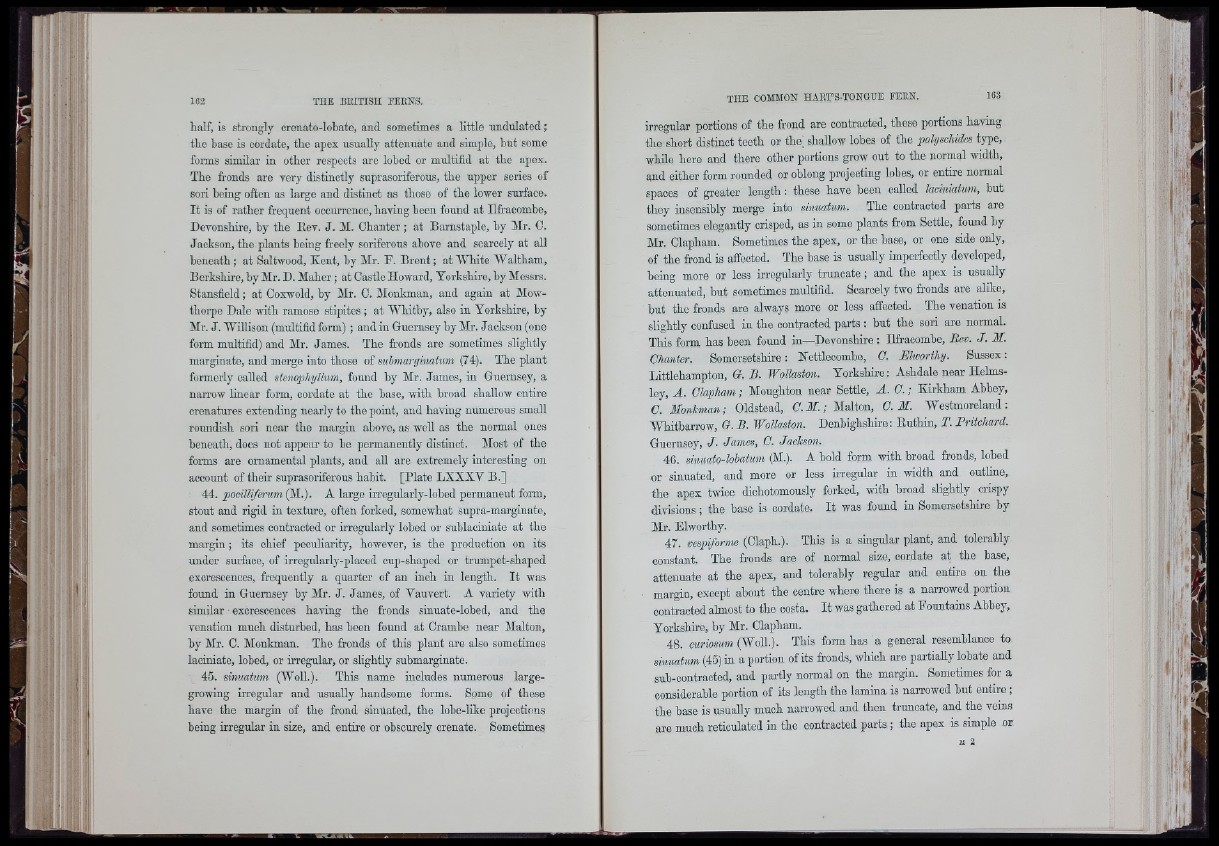
f: f'í half, is strongly cronato-lohato, and sometimes a little undulated;
the base is cordate, tho apex usually attenuate and simple, hut some
fonns similar in other respects are lohcd or multifid at the apex.
The fronds are very distinctly suprasoriferous, the upper series of
sori being often as large and distinct as those of the lower surface.
It is of rather frequent oecurronce, having been found at IKracombe,
Devonshire, by tho Eev. J. M. Chanter; at Barnstaple, by Mr. C.
Jackson, the plants being freely soriferous above and soaroely at all
beneath; at Saltwood, Kent, by Mr. F. Brent; at White AValtham,
Berkshire, by Mr. D. Maher; at Castle Howard, Yorkshire, by Messrs.
Stansfleld; at Coxwold, by Mr. 0. Monkman, and again at Mow-
thoi-pe Dale with ramose stipites ; at AVhitby, also in Yorkshire, by
Mr. J. Willison (multifid form); and in Guernsey by Mr. Jackson (one
form multifid) and Mr. James. Tbe fronds are sometimes slightly
marginate, and merge into those of submarginatum (74). The plant
formerly called stcnoplujlkmi, found by Mr. James, in Guernsey, a
narrow linear form, cordate at the base, with broad shallow entire
crenatures extending nearly to the point, and having numerous small
roundish sori near the margin above, as well as the normal ones
beneath, does not appear to he permanently distinct. Most of the
forms are ornamental plants, and all are extremely interesting on
account of their suprasoriferous habit. [Plate LXXXV B.]
44. pocilliferum (M.). A large irrogularly-lobed permanent form,
stout and rigid in texture, often forked, somewhat supra-marginato,
and sometimes contracted or irregularly lobed or sublaoiniate at the
margin; its chief peculiarity, however, is the production on its
under surface, of irregularly-placed cup-shaped or trumpet-shaped
excrescences, frequently a quarter of an inch in length. It was
found in Guernsey by Mr. J. James, of Vauvert. A variety with
similar • excrescences having the fronds sinuate-lohed, and the
venation much disturbed, has been found at Crambo near Malton,
by Mr. 0. Monkman. The fronds of this plant are also sometimes
laoiniate, lobed, or irregular, or slightly suhmarginate.
45. sinuatum (WoU.). This name includes numerous large-
growing irregular and usuaUy handsome forms. Some of these
have the margin of the frond sinuated, the lobe-lilie projections
being irregular in size, and entire or obscurely crenate. Sometimes
irregular portions of the frond aro contracted, these portions having
the short distinct teeth or the shaUow lobes of the polyschides type,
whilo here and there other portions grow out to the normal width,
and either form rounded or ohlong projecting lobes, or entire normal
spaces of greater length: those have been called laciniatum, but
they insensibly merge into sinuatum. The contracted parts are
sometimes elegantly crisped, as in some plants from Settle, found by
Air. Clapham. Sometimes the apex, or the base, or one side only,
of tho frond is affected. The base is usuaUy imperfectly developed,
being more or less irregularly truncate ; and the apex is usuaUy
attenuated, but sometimes multifid. Scarcely two fronds are alike,
but tho fronds are always more or less affected. The venation is
slightly confused in the contracted parts ; but the sori are normal.
This form has been found in—Devonshire ; Ilfracombe, Bev. J. M.
Chanter. Somersetshire: Nettlecombe, C. Elworthy. Sussex:
Littlehampton, G. B. Wollaston. Yorkshire: Ashdale near Helms-
ley, A. Clapham; Aloughton near Settle, A. C.; Kirkham Abbey,
C. Monkman; Oldstead, C.M.; Alalton, C. M. AVestmoreland:
AVhitbarrow, G. B. Wollaston. Denbighshii’e : Euthin, T. Pritchard.
Guernsey, J. James, C. Jackson.
46. sinuato-lobatum (M.). A bold form with broad fronds, lobed
or sinuated, and more or less irregular in width and outUne,
the apex twice dichotomonsly forked, with broad slightly crispy
divisions; the base is cordate. It was found in Somersetshire by
Air. Elworthy.
47. vespiforme (Claph.). This is a singular plant, and tolerably
constant. The fronds are of normal size, cordate at the base,
attenuate at the apex, and tolerably regular and entire on tee
margin, except about the centre where there is a narrowed portion
contracted almost to tee costa. It was gathered at Eountains Abbey,
Yorkshire, by Air. Clapham.
48. curiosum (WoU.). This form has a general resemblance to
sinuatum (45) in a portion of its fronds, which are partiaUy lobate and
sub-contraoted, and partly normal on the margin. Sometimes for a
considerable portion of its length the lamina is narrowed but entire;
the base is usuaUy much narrowed and teen truncate, and tee veins
are much reticulated in the contracted parts ; the apex is simple or
M 2
I 'D I
I I. !|
I t :
• -IS \
1
it
m
ii'i